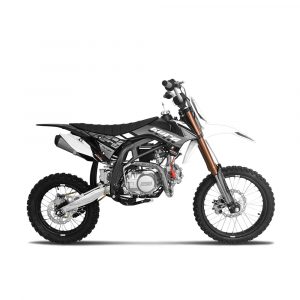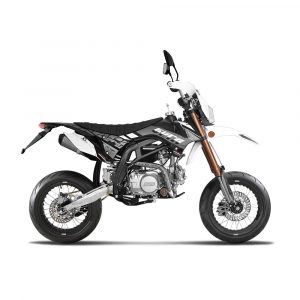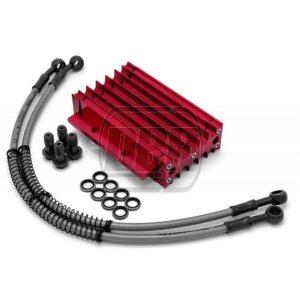TECH DATA

How to fault find on a pit bike
Assembly Problems
Loose or Incorrect Fastenings
- Double-check that all bolts, nuts, and screws are tightened to the correct torque.
- Ensure the handlebar clamps, axle nuts, and engine mounting bolts are secure.
- Verify the rear shock is correctly installed and aligned.
Incorrect Assembly Order
- Refer to the assembly instructions for your specific model.
- Ensure components like spacers, gaskets, and washers are installed in the correct order.
Wiring Connections
- Ensure wiring looms are routed correctly and not pinched or exposed.
- Verify all connectors are properly plugged in. Check that no wires inside each connector block are bent or loose before plugging in.
- Apply corrosion protection grease to terminal pins for preventative protection against moisture and corrosion.
Speedometer Sensor Fitment (Kurz RT1)
- Install the speedometer sensor bracket between the calliper and fork leg, not on the outside of the calliper as often mistaken.
- Adjust the bracket to ensure the sensor aligns closely and correctly with the magnets already fitted within the front brake disc.
- Use the two locknuts to position the sensor 1-3mm away from the magnets for proper magnetic pulse detection as the wheel rotates.
Starting or Poor Running Issues
Starting Procedure
- Add at least 3 litres of fuel to ensure both sides of the fuel tank are full.
- Turn the key switch to the ON position.
- Set the fuel tap to the ON position.
- Lift the carburettor choke lever or pull out the choke button for cold starting.
- Ensure the kill switch is in the RUN position (button out for Kurz RT1 models).
Using the Kick Start:
- For 140cc and above: Find Top Dead Centre (TDC), Slowly press the kickstart lever until the engine reaches TDC, where resistance is strongest. Release the lever to its starting position.
- Firmly and smoothly kick down through the lever in one motion without releasing partway. Avoid stomping or rapid kicks as this will damage the kick-start gears.
- Repeat the process if needed, ensuring you find TDC each time for the most effective kick.
- Avoid excessive throttle during kickstarting, as it can flood the engine and encourage kickback.
Using Electric Start:
- Ensure the bike is in neutral (Green ‘N’ on display).
- Pull in the clutch lever and hold.
- Press the electric start button.
Troubleshooting failed Electric Start:
- If no sound or a clicking/clunking is made by the starter, the battery may need charging.
- if no sound and no lights etc, check the fuse, typically located next to the battery.
- A low battery can still display as 12V on the dash, so do not rely solely on the display to gauge charge level.
Fuel Quality
- Always use fresh E5 premium unleaded fuel to ensure optimal performance.
- Old or low-quality fuel can lead to poor starting and running issues.
- If old fuel is present, drain both the fuel tank and carburettor, then refill with fresh fuel.
- A blocked fuel cap or breather pipe can create a vacuum, restricting fuel flow from the tank. Ensure both are clear.
- If the breather pipe is missing, water from rain or washing can enter the tank and contaminate the fuel. Always ensure the breather pipe is securely fitted.
Valve Clearance
- Ensure valve clearances have been adjusted upon assembly using a valve clearance adjustment tool kit.
- New pit bikes often ship with zero valve clearance from the factory, causing starting and running difficulties.
- Valve clearances should be set during the initial assembly and again at the first service once the valves have been seated. This can be done by either yourself or the dealer.
- Adjust valve clearances to the correct specifications as outlined in the manufacturer’s PDI/assembly guide.
First Service Reminder
- Is the bike new? If so, has it had its first service (200 miles or 10 hours)?
- Never skip the first service—it’s critical! This includes setting the valve clearances accurately.
- Failing to carry out this task will eventually cause the bike to fail to start or even cut out while riding.
- The first service is the most important one! Refer to the service page in the owner’s manual for full details.
Further Troubleshooting
If you have completed these checks and now suspect a fault, use the electrical or mechanical troubleshooting sections below for further guidance:
- Electrical Troubleshooting: If the bike is turning over but not starting (no spark, weak spark, or issues with the battery or wiring), head to the Electrical Troubleshooting section.
- Mechanical Troubleshooting: If the bike is not turning over, there are unusual noises, or you suspect an issue with the engine, carburettor, or valve clearances, head to the Mechanical Troubleshooting section.
Identifying Electrical vs Mechanical Faults
Quick Test for Electrical System Faults
We offer a Simple Pit Bike Wiring Loom Kit (£17) on our website, ideal for testing whether your bike’s electrical system has a fault. In some cases, you may also need a loom adaptor (£6) and a new spark plug (£6) for accurate results. This kit bypasses your bike’s current electrics, helping isolate issues quickly and effectively. Here’s how to test:
- Prepare the Test Loom:
- Fully assemble the simple off-road wiring loom: Kick Start Wiring Loom Kit
- Plug in only the CDI and ignition coil.
- Use a new spark plug for accurate results: NGK Spark Plug 50cc-160cc.
- Disconnect the Current Loom:
- Unplug the wire from the engine, disconnecting the bike’s existing loom.
- Plug the engine’s electrical wire into the test loom.
- You may need a loom adaptor: Engine Loom Adaptor.
- Insert the new spark plug into the new spark plug cap.
- Test for Spark:
- Kickstart the engine and check for a spark at the plug.
- No spark: The stator coil may be faulty – consider a replacement.
- Spark present: The stator coil is working; reconnect the spark plug to the engine.
- Start the Engine:
- Attempt to start the bike with the test loom connected.
- Engine fires up: The problem lies in the original electrical system—focus on electrical troubleshooting.
- Engine doesn’t start: Likely a mechanical issue—refer to mechanical troubleshooting.
This quick test saves time and garage fees while providing useful spare parts for future maintenance!
Quick Test for Mechanical Compression Faults
Carry out a Leak Down Test:
This test measures air escaping from the motorcycle’s combustion chamber to assess engine health. A high percentage of escaping air points to mechanical issues.
Watch a tutorial here: Leak Down Test Video
What to Listen For:
- Hissing at the carburettor: Intake valve leak—possible valve damage or requires valve adjustment
- Hissing at the exhaust: Exhaust valve leak—possible valve damage or requires valve adjustment
- Hissing at the oil filler hole or crank breather pipe: Piston ring seal issue
Electrical Problems
No Spark or Weak Spark
- Test the spark plug by grounding it to the engine and cranking it.
- Replace the spark plug if worn or fouled.
- Check the spark plug cap is securely attached to the cable and make sure it is screwed into the copper core. Trim 10mm from the end of the cable and reattach if needed.
- Ensure no water is present inside either end of the spark plug cap – both where it connects to the spark plug and where the cable screws in.
- Add a cable tie around the cap at the cable entry point to help prevent water from travelling down the cable and entering the cap internals.
- Inspect the wires and terminals from the loom connecting to the ignition coil. Ensure they are clean, free of corrosion, and securely fitted for proper contact.
Faulty CDI or Coil
- Swap the CDI with a known working one to test.
- Ensure the CDI plug does not have water trapped inside. If present, dry it out and check for corrosion on terminal pins. Apply grease or replace the CDI as needed for future preventative measures.
- Test the ignition coil resistance using a multimeter; replace if out of specification.
Kill Switch Issues
- Disconnect the kill switch to rule out faults in the kill switch wiring.
Key Switch Issues
- Unplug the key switch from the wiring loom to isolate it. Test or replace the switch as needed. Perform a continuity test on the wires to ensure proper contact and verify that the switch functions correctly.
Stator or Flywheel Issues
- Inspect the stator and flywheel for damage or misalignment.
- Ensure the stator connections are secure and clean. If connections are twisted and taped, replace them with proper connectors.
- Carry out a test on that stator coil for both voltage and continuity.
Corrosion or Loose Wiring Terminals
Inspect all wiring terminals for signs of corrosion, rust, or looseness, which can disrupt the electrical flow and cause performance issues. Clean corroded terminals using contact cleaner and a brush, then apply dielectric grease to prevent future corrosion. Ensure all connections are securely fastened to maintain a stable electrical system. Pay special attention to ground points and key connections such as the stator, CDI, and ignition coil.
Mechanical Problems
Valve Clearances
- Adjust the valve clearances to IN 0.10mm and EX 0.15mm for optimal performance. Check on a new engine and again after 10 hours of use.
Compression Issues
- Test the engine compression on a leakdown test. If low, inspect the cylinder, piston, rings and valves for wear or damage.
Chain Alignment and Tension
- Ensure the chain is aligned and adjusted to the correct tension. A slack or overtightened chain can cause issues.
Clutch Adjustment
- Check and adjust the clutch cable for proper free play to avoid slipping or dragging.
Carburettor Settings
- A carburettor should not be adjusted when the engine is cold. Leaving the engine idling for 10 minutes will not warm it adequately. Instead, 5 minutes of riding will warm the engine correctly; only then should carb adjustments be made.
- Check the main jet and pilot jet for debris. Clean and reinstall as needed.
- Adjust the air-fuel mixture screw for a smooth idle.
- Ensure the choke is in the correct position:
-
-
- Button type: Out for cold starts, in for a warm engine.
- Lever type: Lift the lever up for cold starts, and push it down for a warm engine.
-
Air Leaks
- Inspect the intake manifold for air leaks. Ensure gaskets and spacers are installed correctly and joints are tightened.
Blocked Fuel Flow
- Check the fuel line and fuel filter for blockages or kinks, remove the fuel pipe from the carb and turn the fuel tap on and off to test the fuel flow.
Worn Components
- Inspect and replace worn spark plugs, air filters, and fuel filters as needed.
Final Checks
Assembly Verification
- Revisit all connections and fastenings after troubleshooting to ensure everything is secure.
Test Ride
- After making adjustments, take the bike for a test ride to confirm the issue is resolved.
Maintenance Schedule
- Regularly maintain your bike according to the manufacturer’s service schedule to prevent recurring issues.
And Finally……..
If you’ve had no luck with the troubleshooting steps above, it may be time to seek specialist help. Book your motorcycle in with your local dealer for a diagnosis. It’s a good idea to provide the dealer with this guide so they can see what you’ve checked so far. This will save them time and ensure nothing has been overlooked.





















